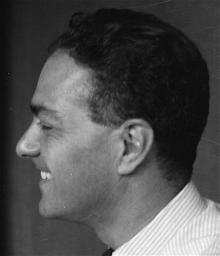
Ernö Goldfinger was born in Budapest, Austria-Hungary [now Hungary], on 11 September 1902. With his family he left Hungary following the communist putsch in 1919. After a year spent at a school in Switzerland, he settled in Paris where he studied architecture and urban planning at the École des Beaux-Arts under Léon Jaussely (1875-1932) and Auguste Perret (1874-1954) from 1922 to c.1924. He also attended the École d'Urbanisme at the Sorbonne in 1927-28. Whilst in Paris he moved in the avant-garde circles of the Left Bank where he associated with artists and architects such as Robert Delaunay, Max Ernst, Man Ray, Le Corbusier, Amédée Ozenfant and Pierre Chareau. From 1924 to 1934 he was in private practice in Paris In 1927 he visited London where he built a shop for Helena Rubenstein. He returned to the city in 1934 and subsequently made it his permanent home, becoming a naturalised British citizen in 1945.
Following his move to London he re-established his architectural practice. In c.1936 he formed a partnership with Gerald Wanklyn Flower (1912-1994) as Goldfinger & Flower. The practice designed a toy shop for Paul and Marjorie Abbatt Limited at 94 Wimpole Street, London (1936); and 1-3 Willow Road, a terrace of three houses at 1–3 Willow Road, Hampstead, London (1937-39).
Goldfinger and Flower also designed furniture and interiors. Three photographs of nursery furniture designed by Goldfinger and Flower for Paul & Marjorie Abbatt Ltd. are illustrated in 'Decorative Art' 1938 (p.128). Some of the toys they designed for Abbatt were exhibited at the Exposition Internationale des Arts et Techniques dans la Vie Moderne in Paris in 1937.
In 1938 Goldfinger designed a stand for ICI at the British Industries Fair at Olympia, London, and the Children's Section for MARS Group Exhibition at Burlington Gallery in London.
During World War Two he designed educational exhibitions for the British armed forces and an air raid shelter at Bedales School in Petersfield Hampshire in 1940.
Among his post-war projects were offices for the Daily Worker newspaper; the headquarters of the British Communist Party; kiosks for the Festival of Britain in 1951, two primary schools for London County Council; Alexander Fleming House [now Metro Central Heights] in London, completed in 1966; a factory, offices and showroom for the furniture company Hille in Watford, Hertfordshire, completed in 1960; Balfron Tower in Poplar, Tower Hamlets, London, 1965-67; and Trellick Tower a 31-floor tower block in Kensal Town, London, completed in 1972.
Goldfinger was a member of the MARS Architectural Research Group. He was elected a Fellow of the Royal Institute of British Architects (FRIBA) in 1966; a Fellow of the Royal Society of Arts (FRSA) in 1968; an Associate of the Royal Academy (ARA) in 1971; and a Royal Academician (RA) in 1975. He died at 2 Willow Road, Hampstead, London on 15 November 1987.
See:
UK Modern House [link below]
Historic England [link below]
Goldfinger, Ernö and Winter, John. 'Ernö Goldfinger'. Contemporary Architects. [Bibliography below]
Elwall, Robert. Erno Goldfinger. London: Academy, 1996 [RIBA Drawings Monograph No.3]
Ernö Goldfinger : Works 1. Compiled by James Dunnett and Gavin Stamp. London : Architectural Association 1983 [Published to accompany an exhibition at the Architectural Association from 2 June to 25 June 1983]
Exhibition of the Work of Ernö Goldfinger RA celebrating his 80th Year. London: Royal Academy of Arts, 1983.
Goldfinger, Ernö. British furniture to-day. London : A. Tiranti 1951
Goldfinger, Ernö and Winter, John. 'Ernö Goldfinger'. Contemporary Architects. Edited by Ann Lee Morgan and Colin Naylor. Chicago, Illinois St. James Press, 2nd edition, 1987 pp. 330-332 [Contains a comprehensive list of Goldfinger’s architectural projects]
Harwood, Elain. Mid-Century Britain: Modern Architecture 1938-1963. London: Batsford, 2021
Harwood, Elain and Powers, Alan. Ernö Goldfinger. London: Historic England, 2020
McDermott, Catherine. 'Ernö Goldfinger'. Contemporary Designers. Edited by Sara Prendergast. Detroit, Michigan: St. James Press, 3rd edition, 1997 pp. 312-313
Powers, Alan. Modern. The Modern Movement in Britain. London: Merrell, 2005
Read, Herbert. 'Ernö Goldfinger'. Architectural Design vol. 33, January 1963 pp. 6-54 [A detailed chronology of the life and work of Ernö Goldfinger]
Richards, J. M. 'Criticism: office building in Albermarle Street, London, W.1.'. Architects' Journal vol. 126, 18 July 1957 pp. 105-107 [Office building designed by Ernö Goldfinger]
Slessor, Catherine. 'Reframing Balfrom'. C20. The Magazine of the Twentieth Century Society, issue 2, 2021 pp. 22-31
Stamp, Gavin and Goldfinger, Ernö. ‘Conversation with Ernö Goldfinger’. Thirties Society Journal no.2, 1982 pp.19-24
Warburton, Nigel. Ernö Goldfinger : the life of an architect. London : Routledge 2004